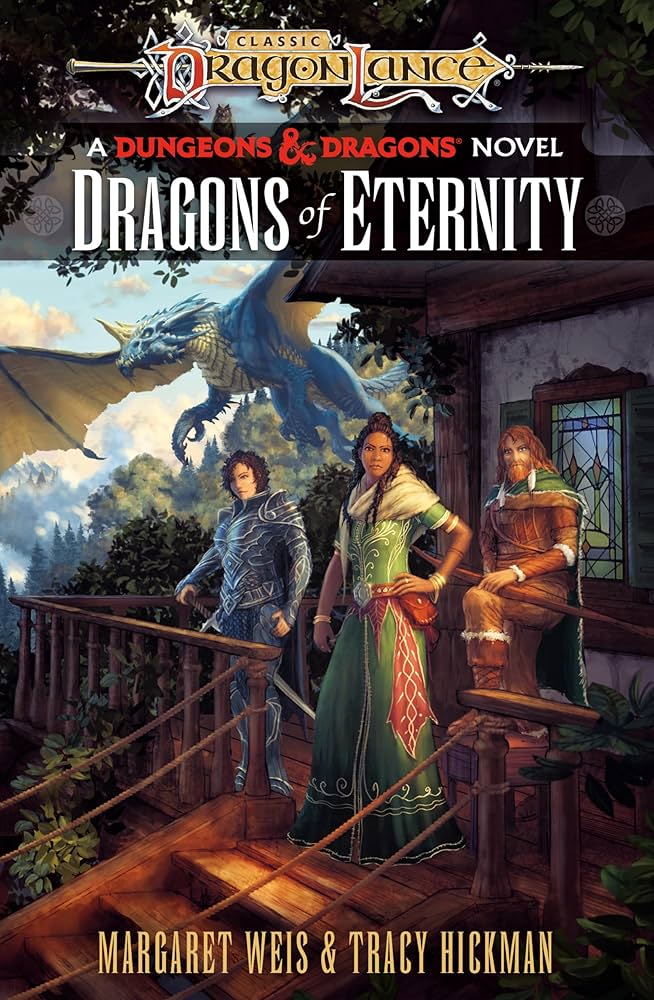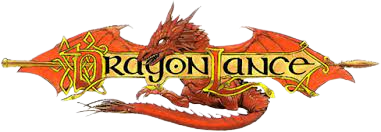Dragons of Eternity

Table of Contents
ToggleOverview
Dragons of Eternity is a time-bending, introspective tale set outside the main Dragonlance timeline, giving readers a rare and compelling glimpse into the mind and soul of Raistlin Majere, the infamous Black Robe mage. This novella stands apart from the sweeping wars and politics of Krynn’s history and instead presents a tight, personal story with mythic resonance.
It’s a story of magic, fate, personal consequence, and what might happen when someone as dangerous and brilliant as Raistlin is faced with a mystery that even he can’t immediately solve.
Main Character: Raistlin Majere
- Arguably the most iconic character in the Dragonlance universe: frail in body, unmatched in arcane power, haunted by mortality, and burdened with immense ambition.
- In Dragons of Eternity, Raistlin is caught in a magical riddle involving time, identity, and death—not as a master of events, but as a curious, uncertain investigator.
- We see him at a rare moment: introspective, vulnerable, and wondering whether he’s become trapped by his own destiny.
Supporting Characters
- Unnamed Dragon Guardian – A being bound to the events Raistlin is unraveling. Not just an adversary, but a metaphor for the magic and memory that binds Krynn’s threads together.
- A Woman from Raistlin’s Past (or Future) – Ambiguous and possibly symbolic, her presence reflects loss, temptation, and echoes of Raistlin’s fractured timeline.
- Mystical Constructs – As this is largely a surreal and symbolic tale, many supporting “characters” take the form of illusions, puzzles, or magical creations—each serving a psychological or philosophical purpose.
Setting
- A timeless, undefined magical space, likely a pocket dimension or metaphysical plane, disconnected from conventional time and geography.
- The setting is minimal and symbolic—a castle, a tower, and shifting dreamlike locales where the environment responds to Raistlin’s thoughts and fears.
- Rather than a fixed place, this novella is set within a metaphysical challenge, where space and time are not as they seem.
Plot Summary
An Intrusion into Eternity
Raistlin enters a place outside of time, believing he is investigating an anomaly—perhaps an artifact, or a residual spell gone awry. But he soon finds that this “place” is not a simple magical phenomenon—it’s a test, a trap, or maybe even a message.
Inside this plane, time loops, moments repeat, and Raistlin is haunted by visions—of possible futures, alternate selves, and fragments of things that never happened but could have.
The Riddle of the Dragon
A dragon appears—not a beast of brute force, but one of memory and philosophy, asking questions Raistlin cannot easily answer.
This dragon is a guardian of eternity, a keeper of continuity, and it challenges Raistlin’s belief in his own power and purpose. Is Raistlin truly destined to be the Master of Past and Present? Or is he simply another mortal who believed too strongly in his own myth?
The dragon may be testing him. Or warning him. Or trying to show him something about the nature of magic, mortality, and time.
Raistlin’s Reckoning
Raistlin finds himself facing versions of himself—some arrogant, some frightened, some regretful.
These echoes challenge his justifications for past decisions, including his thirst for godhood (Legends Trilogy) and the pain he’s caused (Caramon, Crysania, and beyond).
Ultimately, Raistlin rejects the trap of eternity, recognizing that power without purpose is hollow. He chooses to leave the timeless realm, not out of fear—but out of clarity. His destiny must be forged in the flow of time, not outside of it.
Themes
- The Nature of Time – Time here is fluid, abstract, and personal. The story challenges the idea that time can be controlled or escaped.
- Self-Confrontation – Raistlin meets himself—not just literally, but emotionally and metaphysically. It’s a tale of inner reckoning.
- Power vs. Purpose – Power, especially magical power, is questioned: What is it for? Is mastery worth it without meaning?
- Redemption or Ruin? – This story adds complexity to Raistlin’s legacy: Is he damned? Redeemable? Misunderstood? Or merely human in a grand cosmic game?
Tone & Style
- Lyrical, mysterious, and meditative—a far cry from battle-driven or plot-heavy fantasy.
- Written with an emphasis on atmosphere, symbolism, and Raistlin’s inner voice.
- Feels more like a philosophical fable or magical character study than a traditional novella.
Reception
Dragons of Eternity is praised for:
- Offering a unique, thought-provoking glimpse into Raistlin’s character
- A narrative style that feels dreamlike and intimate
- Honoring Raistlin’s complexity without retreading Legends Trilogy territory
- Giving readers a brief but potent tale with lingering emotional impact
Some critiques:
- Too abstract for readers expecting a traditional adventure
- Very short (novella-length), leaving some questions unanswered by design
Final Thoughts
Dragons of Eternity is a brilliant, moody epilogue-style tale that gives Dragonlance’s most enigmatic mage a moment of pause, clarity, and haunting self-awareness. It’s not a story of war or conquest, but of timeless reflection and what it means to live with your choices.
Recommended for:
- Fans of Raistlin Majere who want a quiet, psychological look into his soul
- Readers who enjoy introspective fantasy, riddles, and mythic storytelling
- Anyone curious about magic, mortality, and time in the Dragonlance cosmology
“Time is a cage we build ourselves. And sometimes… the only way out is to walk back into it.”
